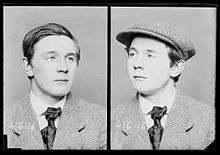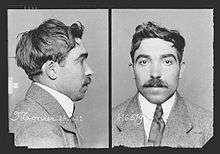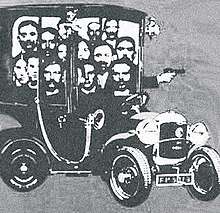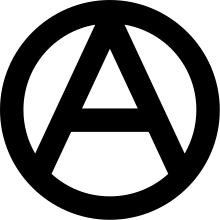Bonnot Gang
The Bonnot Gang (La Bande à Bonnot) was a French criminal anarchist group that operated in France and Belgium during the Belle Époque, from 1911 to 1912. Composed of individuals who identified with the emerging illegalist milieu, the gang used cutting-edge technology (including automobiles and repeating rifles) not yet available to the French police.
Originally referred to by the press as simply "The Auto Bandits", the gang was dubbed "The Bonnot Gang" after Jules Bonnot gave an interview at the office of Le Petit Parisien, a popular daily paper. Bonnot's perceived prominence within the group was later reinforced by his high-profile death during a shootout with French police in Choisy-le-Roi.
Members
The Bonnot Gang originally consisted of a group of French anarchists centered around the individualist anarchist magazine l'Anarchie. The group was founded by Octave Garnier, Raymond Callemin, and René Valet. It was Garnier's idea to use automobiles in the service of a daring criminal act. Jules Bonnot joined them in December 1911.


 Raymond Callemin, executed
Raymond Callemin, executed Étienne Monier, executed
Étienne Monier, executed André Soudy, executed
André Soudy, executed
Principal gang members included:
- Jules Bonnot
- Octave Garnier
- Raymond Callemin
- Anna Dondon
- Marie Vuillemin
- André Soudy
- Édouard Carouy
- Jeanne Belardi
- Jean De Boe
- Étienne Monier
- Eugène Dieudonné
Minor players included David Belonie, Marius Medge, Antoine Gauzy, Pierre Jourdan (anarchist), Charles Reinart, Victor Serge, Godorowski, Henriette Maîtrejean, and Berbe Leclech.
The gang's political and social perspective was heavily influenced by Mikhail Bakunin and Pierre-Joseph Proudhon as well as Max Stirner, Ludwig Büchner, and Friedrich Nietzsche. Bonnot's ideas were more part with late anarchist Ravachol.
Crime spree

The first robbery by Bonnot's Gang was on December 21, 1911 at the AB Branch of Société Générale Bank, located at 148 rue Ordener in the 18th Arrondissement of Paris. They shot a collection clerk in the neck and lung (yet he survived), snatched his cash bags,[1] then escaped in an automobile (a Delaunay-Belleville) they had stolen a week before. Robbers – Bonnot, Octave Garnier, Eugène Dieudonné and Raymond Callemin – got earnings equal to 5,126 francs, but the rest of it was composed of securities.
On December 28, 1911, the gang broke into a gun shop in the Paris center. A few days later, on the night of January 2, 1912, they entered the home of the wealthy M. Moreau and murdered both him and his maid. The take was equal to 30,000 francs.
The National Police did its best to catch the gang. They were able to arrest one man based on their registry of anarchist organisations. The Gang fled temporarily to Belgium, where they sold the stolen automobile and tried to carjack another. In the process they shot a Belgian policeman.
The gang continued their automobile thefts and robberies, shooting two more policemen in the process. Automobiles were not yet common so the gang usually stole still expensive cars from garages, not from the street.
By March 1912, police had arrested many of the gang's supporters and knew many of the members' faces and names. In March 1912, gang member and would-be leader Octave Garnier sent a mocking letter to the Sûreté – with his fingerprints. In those days, the French police still did not yet use fingerprinting.
On March 25, 1912, the gang stole a de Dion-Bouton automobile in the Forest of Sénart south of Paris by shooting the driver through the heart.[2] They drove into Chantilly north of Paris where they robbed the local branch of Société Générale Bank – fatally shooting two bank cashiers and severely wounding a bookkeeper.[1] They escaped in their stolen automobile as two policemen tried to catch them, one on horseback and the other on a bicycle.
Sûreté Chief Xavier Guichard took the matter personally. Even politicians became concerned, increasing police funding by 800,000 francs. Banks began to prepare for forthcoming robberies and many cashiers armed themselves. The Société Générale promised a reward of 100,000 francs for information that would lead to arrests.[1]
Pursuit and capture
On March 30, police arrested André Soudy at the English Channel coast, where he announced that he did not care whether he died of tuberculosis or by guillotine. Édouard Carouy was arrested April 3. Raymond Callemin was arrested April 7, and police had to prevent an angry mob from lynching him on the spot. Étienne Monnier was arrested in Paris on April 24. By the end of that month, police had arrested 28 gang members and supporters. Still, Bonnot, Octave Garnier and René Valet remained at large.
On April 24, three police officers surprised Bonnot in the apartment of a suspected fence. He shot at the officers, killing one and wounding another, and then fled over the rooftops. Part of the 100,000 francs reward was later given to the widow of the police officer killed (Louis Jouin, the vice-chief of the French National Police).
On April 28, police had tracked Bonnot to a converted garage in the Paris suburb of Choisy-le-Roi. The building had only one entrance so it was easy for Bonnot to keep the police at bay. They besieged the place with 500 armed police officers, soldiers (with one brand new Hotchkiss machine gun), firefighters, military engineers and private gun-owners. By noon, after a sporadic firing from both sides, Paris Police Chief Louis Lépine sent three police officers to put a dynamite charge under the house. The explosion demolished the front of the building. Bonnot was hiding in the middle of a rolled mattress and tried to shoot back until Lépine shot him non-fatally in the head. Afterwards police again had to prevent the spectators from lynching Bonnot. They simply told the crowd that Bonnot was already dead and had been buried in a secret grave. In fact, he was fatally injured but was taken to the Hôtel-Dieu hospital and survived for around another hour.
On the evening of 14 May, Octave Garnier and Rene Valet were besieged in the Paris suburb of Nogent-sur-Marne by a large force including 300 police officers and gendarmes and 800 soldiers. Sûreté Chief Xavier Guichard himself led the siege. The firing from both sides was intense, and at 2 am, Guichard decided to blow the place up. Garnier died in the explosion, but Valet tried to keep firing despite his wounds.
Trial
The trial of the gang's survivors began on February 3, 1913. Victor Serge was sentenced to five years for robbery. All the others were initially sentenced to death. The sentence of Eugène Dieudonné was commuted to life imprisonment. Sentences of Édouard Carouy and Marius Metge were commuted to life imprisonment at hard labor. Carouy later committed suicide. Metge was sent to a penal colony. Raymond Caillemin, Étienne Monier and André Soudy refused to plead for clemency and they were executed by guillotine.
Aftermath

In the aftermath of the collapse of the Bonnot Gang, French authorities used the threat of anarchist violence as the pretext for a substantial expansion in law enforcement power. Hundreds of raids were carried out against known anarchists and sympathizers (similar in scale to the Palmer Raids in the United States). Although the actions of the gang were not widely supported, even within the anarchist milieu, the mainstream press called for a general crackdown on left-wing revolutionary activity.
French anarchist communists attempted to distance themselves from illegalism and individualist anarchism as a whole. In August 1913, the Fédération Communiste-Anarchistes (FCA) condemned individualism as bourgeois and more in keeping with capitalism than communism.
Nevertheless, the Bonnot Gang found some sympathy from the French working-class. As many as one hundred thousand people visited Nogent-sur-Marne (the site of the shoot-out that ended the lives of Garnier and Valet) and merchants in Paris sold souvenirs depicting the bandits.
The Bonnot Gang remains one of France's best known anarchist groups.
See more
- La Bande à Bonnot, 1968 film
- Les Brigades du Tigre
References
- ""Skedaddle!" The Bonnot Gang targets Societe Generale". Societe Generale. Retrieved September 11, 2019.
- Richard Parry: The Bonnot gang. Rebel Press, 1987, ISBN 978-0-946061-04-4, p. 115.
Further reading
- Cacucci, Pino. (2006) Without a Glimmer of Remorse. ChristieBooks. ISBN 1-873976-28-3.
- Imrie, Doug. (1994) The Illegalists. Anarchy: A Journal of Desire Armed.
- Merriman, John M. (2017). Ballad of the Anarchist Bandits: The Crime Spree that Gripped Belle Epoque Paris. Nation Books. ISBN 978-1568589886.
- Parry, Richard. (1987) The Bonnot Gang. Rebel Press. ISBN 0-946061-04-1.
External links
| Wikimedia Commons has media related to Bande à Bonnot. |
